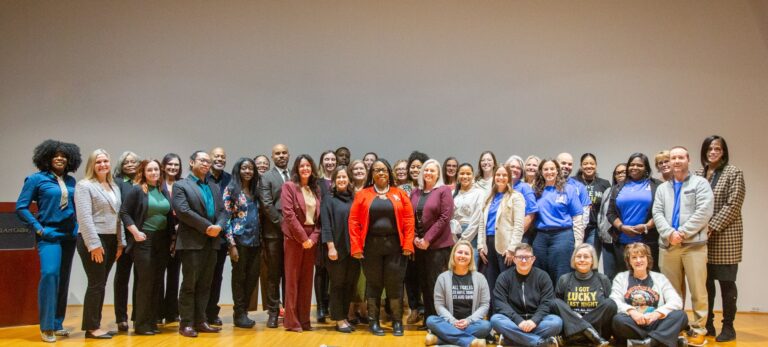As morning snack is wrapping up, preschoolers in Head Start classrooms across western New York are gathering in groups to swish and swallow, and to brush their teeth. “It’s now become a competition to see who can brush harder,” said Theresa Wells, coordinator of Health, Disparities and Nutrition for Cattaraugus Wyoming Counties Project Head Start, “We aren’t changing behaviors, we are instilling them.”
Introducing the positive habit of brushing your teeth twice a day is a small piece of the Cavity Free Kids curriculum that is being taught weekly to preschoolers in Western New York. A rich collection of lessons, activities, stories and songs actively engage young children in fun-filled, play-based learning, while curriculum places an additional emphasis on practicing good oral health habits at home.
“Brushing is really important in our house. I really appreciate the curriculum because good oral hygiene is taught at home, and it is carried over and reinforced in school,” said Dayna Barker whose son Jayden attends Northwest Academy Head Start in Buffalo, NY.
According to the American Academy of Pediatric Dentistry, tooth decay is the single most common chronic childhood disease – five times more common than asthma, four times more common than childhood obesity and 20 times more common than diabetes. And dental caries are disproportionately concentrated among disadvantaged children, especially those who qualify for Medicaid coverage.
Cavity Free Kids, part of the Health Foundation’s CHOMPERS! Bringing Dental Care to Kids initiative, is a best practice oral health curriculum developed by the Washington Dental Service Foundation. The Health Foundation launched the program in 2010 and works with organizations throughout western and central New York to help young children in both regions develop lifelong dental health habits and better oral health.
“The bottom line is tooth decay is entirely preventable. By engaging children early, we can teach them that good oral health leads to overall good general health. Since we introduced the Cavity Free Kids curriculum in 2010, we have seen the number of our preschoolers regularly attending dental visits increase dramatically,” explained Chris Tedesco, health coordinator at Holy Cross Head Start. Tedesco reports that only 10 out of the 497 Holy Cross Head Start students went without a dental visit last year.
Wells, too, is seeing consistent positive results in her community. “We look at the curriculum and say let’s start small, and let the children process and change one behavior at a time and build from there. And before we know it, we have the entire family practicing good oral health,” said Wells.
To spread this program even further, Holy Cross and Cattaraugus Wyoming Counties Project Head Start will serve as Cavity Free Kids hubs, providing information, referrals and resources, as well as training new Cavity Free Kids trainers across the region.
Expanding the program will allow preschoolers beyond Head Start classrooms to participate in Cavity Free Kids.
“We are continuing to build upon our contacts from the community outreach we have done over the last two grant cycles. This will help us position ourselves for the long term sustainability of Cavity Free Kids. Our mission from day one is to maintain the curriculum and team so that we can always meet the demands and needs of everyone interested in it,” explained Wells.
Wells is reaching beyond the classroom setting by working with county health educators at WIC offices and health departments, setting up informational tables at clinic days and continuing the practice of participating in health fairs and open houses. She is also working with ACCORD Corporation to train home day care centers.
As the lead for Erie County, Tedesco is taking the curriculum to WIC, the Department of Social Services and day cares. Tedesco is also getting creative by offering the curriculum to non-traditional settings such as Aspire of Western New York and The Summit Center, both of which are agencies that work with people that have developmental disabilities.
“I want to think outside of the box and offer this program to any interested partner. I tell them to tell me their needs and we will brainstorm around ways to make it work,” Tedesco said.
Both Wells and Tedesco credit the flexibility and adaptability of the Cavity Free Kids curriculum for their ability to introduce the program in so many different learning environments.
“What’s so wonderful about this curriculum is that it’s positively received by all teachers, and that is has reinvigorated not only oral health, but healthy eating as well. The materials present new ideas in a very simplified way. There are phrase sections, big bites and fun facts with conversation starters,” said Wells.
Tedesco agreed that the curriculum is very easy to follow and provides guidance towards how to incorporate the weekly activity into the lesson plan. She believes the lesson is the perfect length, and that it is age appropriate and engaging, all while meeting the head start performance standards for oral education.
Nadine Deluca a preschool teacher at North West Academy Head Start, shared Well’s and Tedesco’s enthusiasm. “My classroom gets excited by the props and hands-on activities with the puppets, along with the big mouth that allows children to practice proper teeth brushing. The curriculum is right on their level, so they understand what they are learning. And with little classroom funding, I appreciate that we receive the props, activities, dental floss and tooth brushes for each child as a part of the kit at no cost , “ Deluca said.
Wells stated that she feels very fortunate to be able to walk into a daycare that is barely making ends meet and to be able to provide them with toothbrushes and Cavity Free Kids supplies. She noted that the largest trend she is seeing across the counties she is working in is a reduction in funding for community programs, and even an elimination of funding for parent education programs.
“As funds are shifted into what may seem like higher priority areas of importance, we realize that unfortunately any reduction in education programming is going to negatively affect the people living in the communities. With this opportunity, I feel fortunate to be that champion that can offer both education and supplies,” Wells said.
Over the next two years, the two organizations want to reach 5,000 new children and families, provide Cavity Free Kids curriculum kits and supplies across eight counties; train 125 early childhood teachers and providers in the Cavity Free Kids curriculum and partner with new agencies and facilities to expand the program to even more classrooms.
Independent evaluations confirm the enthusiasm that is building in Western New York around Cavity Free Kids. In addition to teachers’ excitement surrounding the program and the growing number of children reached, evaluators found that parents oral health knowledge increased following Cavity Free Kids and that 97% of parents agreed that oral health and proper dental care are priorities. Additionally, day-to-day oral health practices and habits improved; more children were frequently eating fruits and vegetables; using fluoride toothpaste; drinking water with fluoride and brushing and flossing their teeth at home. The evaluation also found that young children were visiting the dentist more often and parents’ confidence in supporting their child’s oral health improved. The majority of children reached through Cavity Free Kids now receive regular dental care.
“All of us at Holy Cross eat, sleep and drink Cavity Free Kids,” exclaimed Tedesco.
For preschoolers across western New York this means they are on the right track towards healthy teeth and a healthy smile.



